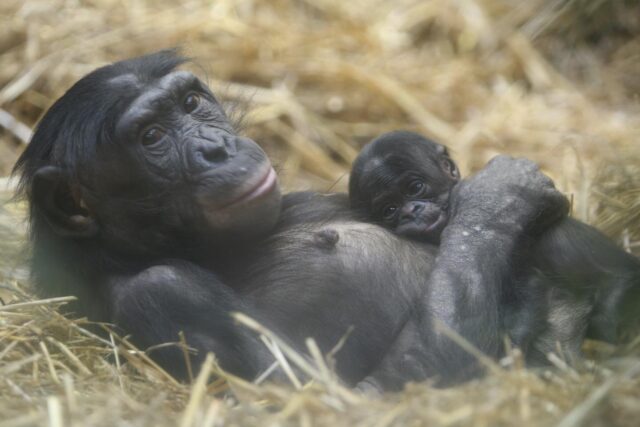Chimpanzees and bonobos diverged comparatively recently in great ape evolutionary history. They split into different species about 1.7 million years ago. Some of the distinctions between chimpanzee (Pan troglodytes) and bonobo (Pan paniscus) lineages have been made clearer by a recent achievement in hominid genomics.
A new bonobo genome assembly has been constructed with a multiplatform approach and without relying on reference genomes. According to the researchers on this project, more than 98% of the genes are now completely annotated and 99% of the gaps are closed.
The high quality of this assembly is allowing scientists to more accurately compare the bonobo genome to that of other great apes — the gorilla, orangutan, chimpanzee — as well as to the modern human. All these species, as well as extinct, ancient, human-like beings, are referred to as hominids.
Because chimpanzee and bonobo are also the closest living species to modern humans, comparing higher-quality genomes could help uncover genetic changes that set the human species apart.
In a May 5 Nature paper, researchers explain how they developed and analyzed the new bonobo assembly, and what juxtaposing it to other great ape genomes is revealing.
Find your dream job in the space industry. Check our Space Job Board »
The multi-institutional project was led by Yafei Mao, of the Department of Genome Sciences at the University of Washington School of Medicine in Seattle, and Claudia R. Catacchio, of the Department of Biology at the University of Bari, Italy. The senior scientists were Evan Eichler, professor of genome sciences at the UW School of Medicine, and Mario Ventura of the University of Bari. Eichler is also a Howard Hughes Medical Institute investigator.
By comparing the bonobo genome to that of other great apes, the researchers found more than 5,571 structural variants that distinguished the bonobo and chimpanzee lineages.
The researchers explained in the paper, “We focused on genes that have been lost, changed in structure, or expanded in the last few million years of bonobo evolution.”
The great ape genome comparisons are also enabling researchers to gain new insights on what happened to the various ape genomes during and after the divergence or splitting apart into different species from a common ancestor.
They were particularly interested in what is called incomplete lineage sorting. This is the less-than-perfect passing along of alleles into the separating populations as species diverge, as well as the loss of alleles or their genetic drift. Analyses of incomplete lineage sorting can help clarify gene evolution and the genetic relationships among present-day hominids.
The higher-quality bonobo genome assembly enabled the researchers to generate a higher resolution map comparing incomplete lineage sorting in hominids. They identified regions that are inconsistent with the species tree. In addition, they estimate that 2.52% of the human genome is more closely related to the bonobo genome than the chimpanzee genome, and 2.55% of the human genome is more closely related to the chimpanzee genome than the bonobo genome.
The total proportion based on incomplete lineage sorting analysis (5.07%) is almost double earlier estimates (3.1%).
“We predict a greater fraction of the human genome is genetically closer to chimpanzees and bonobos compared to previous studies,” the researchers note.
The researchers took their incomplete lineage sorting analysis back 15 million years to include genome data from orangutan and gorilla. This increased the incomplete lineage sorting estimates for the hominid genomes to more than 36.5%, which is only slightly more than earlier predictions.
Surprisingly, more than a quarter of these regions are distributed non-randomly, have elevated rates of amino acid replacement, and are enriched for particular genes with related functions such as immunity. This suggests that incomplete lineage sorting might work to increase diversity for specific regions.
The new bonobo genome assembly is named for the female great ape whose DNA was sequenced, Mhudiblu, a current resident of the Wuppertal Zoo in Germany. The researchers estimate that sequence accuracy of the new assembly is about 99.97% to 99.99%, and closes about 99.5% of the 108,390 gaps in the previous bonobo assembly.
The bonobo is one of the last great ape genomes to be sequenced with more advanced long-read genome sequence technologies, the researchers noted.
“Its sequence will facilitate more systematic comparisons between human, chimpanzee, gorilla and orangutan without the limitations of technological differences in sequencing and assembly of the original reference,” according to the researchers.
Provided by: University of Washington School of Medicine
More information: Mao, Y., Catacchio, C.R., Hillier, L.W. et al. A high-quality bonobo genome refines the analysis of hominid evolution. Nature (2021). doi.org/10.1038/s41586-021-03519-x
Image: Mhudiblu, a female bonobo, holds her daughter Akema. Mhudiblu’s DNA was sequenced to help construct a new, high-quality bonobo genome assembly for great ape and other hominid evolution and genetic research
Credit: Claudia Philipp/Wuppertal Zoo Germany











